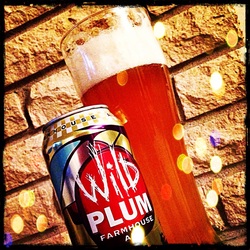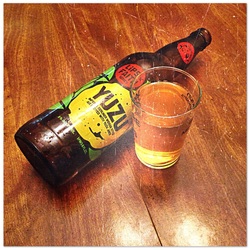
I like plums. They are one of my favorite stone fruits, next to a good fresh peach. While out building my last “BYO Six Pack”, I happened to spot a can of Tallgrass Brewing’s Wild Plum Farmhouse Ale. And you know what? I like all four of those words. All four of those words put together… even better.
I chilled my brightly colored can this weekend and cracked it open just before dinner. The beer smelled like a beer. Nothing special really popped out at me – maybe a little citrus twang. Poured into my glass, it was very heady and a nice light amber color with a fairly clear body. It still didn’t really smell much like anything more than a beer.
Both pro and retronasal, there wasn’t a lot of pop to a plum flavor, which when the beer advertises itself as a Wild Plum beer made with Fresh Picked Wild Plums… I kind of expect that plum flavor somewhere. I don’t know if it just got lost in the stronger yeast flavors of the beer, but I really couldn’t pick up any lick of plum. Maybe if I thought really hard about at the end. Maybe if I pictured a plum mentally while drinking it.
Overall, I wasn’t very impressed with this beer and I probably wouldn’t try it again. I would probably try it on tap if I were to ever find it, since I think that might be the only thing to make that distinct stone fruit flavor pop out.
I didn’t dislike it, I just didn’t like it. I’d pick it over a non-craft beer any day, but I was really hoping for more of that sweet, juicy plum on my tongue.
Beer: Wild Plum
Style: Farmhouse Ale
Brewery: Tallgrass Brewing
ABV: 5.6%
Served from: Can
Rating: 2.5/5 - Really, it didn't strike me as anything special.

I have to admit I am in love with the Lips of Faith series. I love the concept and I love the bottles. This is the fourth Lips of Faith beer I have tried from New Belgium (the first being La Folie 2013, the second was Transatlantique Kriek, and the third La Terrior). I have been excited to sample this beer ever since I bought it.
I did not know what Yuzu was prior to holding this bottle in my hand. My sister-in-law thought that Yuzu was only an incense scent. I thought it was just a cool name for a beer. Low and behold, it is an actual thing. Color me enlightened.
Strap on your learning hat, it’s time to learn about Yuzu!
Other than being a really cool word, the Yuzu fruit is an Asian citrus plant that is found in China, Korea, Tibet and Japan. When looking at a Yuzu, you may think it looks a bit like a miniature grapefruit. That is probably because it does. I could also hear an argument for a yellow orange. The Yuzu fruit is used in plenty of Asian cuisine, but because of it’s very tart nature, the rind is the usual suspect. The juice is normally sweetened and made into a syrup before it is used in culinary products. The flavor itself is orange-y with a hint of that strong bitter flavor of a white grapefruit.
When I cracked the bottle open, the earthy peel scent was already teeming. This worried me a little, since I am hesitant on lemon flavored anything. Especially in beers. I have had too many “lemon” flavored whosiewhats that just end up tasting like lemon bathroom cleaner. I poured four glasses for me and my zombie buddies and we all enjoyed our first Yuzu brewed beer.
The Yuzu poured a very cloudy golden hay color and had minimal head with big, full bubbles. The smell of the Yuzu peel was strong and acidic, but not in an offensive way. It was very light and smooth in the mouth with a really even taste throughout the tongue. The blending done on this beer was superb. Nothing stood out over anything else. It was just very well balanced. You got that bright lemon-grapefruit pop of the Yuzu right away, and then it mellowed out into a very familiar orange zest flavor. I believe that since this beer was brewed with Lactobacillus and Breattanomyces this lets it live in the world of sour beers. New Belgium has qualified it as a Berliner Weisse – and it has all the classic beer qualities of a good Weisse as well. I would certainly buy this one again and keep it around for those long Minnesota winters when the Yuzu’s citrusy flavors will remind me that eventually this harsh cold will end and the beaches will be open once more. What can I say? I have a flare for the dramatic.
Beer: Yuzu
Style: Berliner Weisse
Brewery: New Belgium Brewery - Lips of Faith
ABV: 8%
Served from: Bomber
Rating: 4/5 - I will certainly pick up another!
It is a debatable topic amongst beer connoisseurs as to what defines a craft beer or brewery. Many believe simply that a non-commercial beer is a craft beer, while others put much more restrictive definitions around the craft beer phenom.
My question to you: What Defines a Craft Brew to You?
You may hear the terms “macrobrew” and “microbrew” being tossed around when you enter the world of craft beer. Some will even use this to define their meaning of a craft beer. Simply put, a macrobrew is a beer that is easily produced commercially, or in large batches. Think Anheuser-Busch. A microbrew is produced on a much smaller scale, typically under the careful eye of a master brewer who thinks of each batch as his baby. That may sound a bit dramatic, but trust me – some brewmasters really do feel this way.
As defined by CraftBeer.Com, you can know to classify the brew you’re drinking as a craft beer if the brewery produces six million barrels or less a year at their location. That may sound like a lot, but think of the mass-production given to non-craft brews like Budweiser. Your beer may also be craft if the brewery producing the beer is not owned by a larger conglomerate or parent company who is not also a craft brewer. This is a fuzzy line, however.
You can take the case of Brewery Ommegang, which was purchased by a much larger company, Duvel. Duvel has allowed Ommegang to fly their own kite and hasn’t asked them to mass-produce or change what they do. The perk for Ommegang is that they are now hooked up with a bigger distribution team who can spread the good news of their delicious beers farther around the country. Ommegang is still a craft brewery, but now they are able to have name recognition and distribution to areas they never were able to reach before. Do you still consider them to be craft?
Some may even consider Samuel Adams to be a macrobrewery, while others consider it a microbrewery. It is large enough to have national distribution and brand recognition, but Samuel Adams does enough small batch brewing of their seasonals and special releases that this macro/micro line gets blurred.
As you can see, the definition is a little cloudy when it comes to true craft beer. The way I like to think about it is that if I can walk in to any liquor store anywhere and pick up a case of this specific brand or style, it is more likely a macrobrew and it’s probably not craft. This doesn’t hold true on all cases, mind you. If you are located by a brewery, you may be able to find beers others can’t on a mass level. I, for one, can’t find Yuengling out here in the Midwest, but I know how common it is on for east coasters. They may feel the same about Leinenkugel’s – a beer I consider to be a run of the mill commercial beer, available in every liquor store and bar where I am from.
Where do you think is the appropriate place to draw the line? What’s the difference between a craft beer and a rare to find beer in your area? Can a macrobrewery produce craft beers?
Nevertheless, amid all the bottles and barrels, I say go with your gut instinct. Branch out. Pick up a bottle you have never seen before in your life. What you are holding is your gateway to better beer.


 RSS Feed
RSS Feed